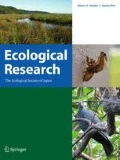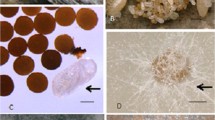Brown balls, of a similar size but different shape to termite eggs, were found frequently in the piles of eggs of the subterranean termite Reticulitermes speratus. rDNA analysis identified the ball as the sclerotia of the fungus, Fibularhizoctonia sp. nov, which is phylogenetically closest to decay fungi, Athelia spp. Laboratory observation showed that the workers gathered the eggs and the sclerotia indiscriminately, even if they were widely scattered in a Petri dish, and piled them up in a specific place for egg care. We compared the morphology of the eggs with that of sclerotia of Fibularhizoctonia spp. and Athelia spp. in relation to egg carrying behaviour, and found that the workers could only carry the Fibularhizoctonia spp. sclerotia whose diameters were similar to the short diameter of the eggs. We also conducted a bioassay using termite eggs and dummy eggs (glass beads and sea sand) of two diameter-classes, coated with or without the egg-derived chemicals. The workers recognized the eggs based on a combination of the size, shape, and chemical cues. All the results suggested that the sclerotia mimic the eggs both morphologically and chemically. Finally, we found that the workers suppressed germination of sclerotia, and termite egg survival increased in the presence of sclerotia only if they were tended by the workers. If the workers were removed experimentally, the sclerotia germinated and grew by exploiting termite eggs. These results suggest that the sclerotia protect termite eggs from putative pathogens.
Similar content being viewed by others
REFERENCES
Adams G. C. (1996) Athelia arachnoidea, the sexual stage of Rhizoctonia carotae, a pathogen of carrot in cold storage. Mycologia 88: 459–472.
Amburgey T. L. (1979) Review and checklist of the literature on interactions between wood-inhabiting fungi and subterranean termites: 1960–78. Sociobiology 4: 279–296.
Felsenstein J. (1993) PHYLIP (Phylogeny Inference Package), version 3.5c. Distributed by the author. Department of Genetics, University of Washington, Seattle.
Iwata. R., Monden A., Yoshikawa T., Kikuchi T., Yamane A. (1999) Grooming and some other inter-individual behavioral actions in Reticulitermes speratus (Isoptera: Rhinotrermitidae), with reference to the frequency of each action among caste stages. Sociobiology 34: 45–64.
Kirk T. K. & Cowling E. B. (1984) Biological decomposition of solid wood. In: The Chemistry of Solid Wood. (ed. R. Rowell) pp. 455–487. American Chemical Society, Washington, D.C.
Kuno E. (1986) Methodology for studies in animal population dynamics I. Population Estimation. Kyoritsu Shuppan, Tokyo, Japan.
Morimoto K. (1968) Termites of the genus Reticulitermes of Japan and Taiwan. Bulletin of the Government Forest Experiment Station 217: 43–73.
Oda T., Tanaka C., Tsuda M. (1999) Molecular phylogeny of Japanese Amanita species based on nucleotide sequences of the internal transcribed spacer region of nuclear ribosomal DNA. Mycoscience 40: 57–64.
Rosengaus R. B., Guldin M. R., Traniello J. F. A. (1998) Inhibitory effect of termite fecal pellets on fungal spore germination. Journal of Chemical Ecology 24: 1707–1706.
Saitou N. & Nei M. (1987) The neighbor-joining method: A new method for reconstructing phylogenic trees. Molecular Biology and Evolution 4: 406–425.
Sambrook J., Fritsch E. F., Maniatis T. (1989) Molecular Cloning. A Laboratory Manual, 2nd edn. Cold Spring Harbor Laboratory Press. Cold Spring Harbor, USA.
Sokal R. R. & Rohlf F. J. (1995) Biometry 3rd edn. W. H. Freeman, New York.
Thomas R. J. (1987) Factors affecting the distribution and activity of fungi in the nest of Macrotermitinae (Isoptera). Soil Biology and Biochemistry 19: 343–349.
Thompson J. N. (1982) Interaction and Coevolution. Wiley-Interscience, New York.
Thompson J. D., Higgins D .G., Gibson T. J. (1994) Clustal W: improving the sensitivity of progressive multiple sequence alignment through sequence weighting, positions-specific gap penalties and weight matrix choice. Nucleic Acids Research 22: 4673–4680.
Waller D. A. & LaFage J. P. (1985) Nutrition ecology of termites. In: Nutrition Ecology of Insects, Mites, Spiders, and Related Invertebrates. (eds F. Slansky Jr. & J. G. Rodriguez) pp. 487–532. Wiley-Interscience, New York.
White T. J., Bruns T., Lee S., Taylor J. (1990) Amplification and direct sequencing of fungal ribosomal RNA genes for phylogenetics. In: PCR Protocols: A Guide to Methods and Applicatio. (eds M. A. Innis, D. H. Gelfand, J. J. Sninsky and T. J. White) pp. 315–322. Academic Press, San Diego.
Wicklow D. T. & Cole R. J. (1982) Tremor-genic indole metabolites and aflatoxins in sclerotia of Aspergillus flavus Link: an evolutionary perspective. Canadian Journal of Botany 60: 525–528.
Wilding N., Collins N. M., Hammond P. M., Webber J. F. (1989) Insect-Fungus interactions. Academic Press, New York.
Wood T. G. & Thomas R. J. (1989) The mutualistic association between Macrotermitinae and Termitomyces. In: Insect–Fungus Interactions. (eds N. Wilding, N. M. Collins, P. M. Hammond & J. F. Webber) pp. 69–92. Academic Press, New York.
Zoberi M. H. & Grace J. K. (1990) Fungi associated with the subterranean termite Reticulitermes flavipes in Ontario. Mycologia 82: 289–294.
Author information
Authors and Affiliations
Corresponding author
About this article
Cite this article
Matsuura, K., Tanaka, C. & Nishida, T. Symbiosis of a termite and a sclerotium-forming fungus: Sclerotia mimic termite eggs. Ecol Res 15, 405–414 (2000). https://doi.org/10.1046/j.1440-1703.2000.00361.x
Received:
Accepted:
Issue Date:
DOI: https://doi.org/10.1046/j.1440-1703.2000.00361.x




